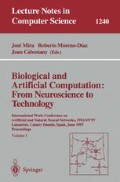Abstract
This paper describes the forward-backward module: a simple building block that allows the evolution of neural networks with intrinsic supervised learning ability. This expands the range of networks that can be efficiently evolved compared to previous approaches, and also enables the networks to be invertible i.e. once a network has been evolved for a given problem domain, and trained on a particular dataset, the network can then be run backwards to observe what kind of mapping has been learned, or for use in control problems. A demonstration is given of the kind of self-training networks that could be evolved.
Preview
Unable to display preview. Download preview PDF.
References
D. Chalmers, “The evolutions of learning: an experiment in genetic connectionism,” in Proceedings of the 1990 Connectionist Models Summer School (D. Touretzky, J. Elman, T. Sejnowski, and G. Hinton, eds.), San Francisco: Morgan Kaufman, (1990).
S. Bengio, Y. Bengio, and J. Cloutier, “Use of genetic programming for the search of a new learning rule for neural networks,” in Proceedings of IEEE International Conference on Evolutionary Computation, pp. 324–327, Orlando: IEEE, (1994).
B. Yamauchi and R. Beer, “Sequential behaviour and learning in evolved dynamical neural networks,” Adaptive Behaviour, vol. 2, pp. 219–246, (1994).
S. Lucas, “Evolving neural network learning behaviours with set-based chromosomes,” in Proceedings of European Symposium on Artificial Neural Networks (ESANN '96), pp. 291–296, Brussels: D facto, (1996).
D. Fogel, “Using evolutionary programming to create networks that are capable of playing tic-tac-toe,” in Proceedings of IEEE International Conference on Neural Networks, pp. 875–880, San Francisco: IEEE, (1993).
D. Dasgupta and D. McGregor, “Designing application specific neural networks using the structured genetic algorithm,” in Proceedings of COGANN-92 — IEEE International Workshop on Combinations of Genetic Algorithms and Neural Networks, pp. 87–96, Baltimore: IEEE, (1992).
L. Marti, “Genetically generated neural networks ii: searching for an optimal representation,” in Proceedings of the International Joint Conference on Neural Networks (Baltimore '92), pp. I, 221–226, San Diego, CA: IEEE, (1992).
J. McDonell and D. Waagen, “Neural network structure design by evolutionary programming,” in Proceedings of the Third Annual Conference on Evolutionary Programming (D. Fogel and W. Atmar, eds.), pp. 79–89, Evolutionary Programming Society, (1993).
J. McDonell, W. Page, and D. Waagen, “Neural network construction using evolutionary search,” in Proceedings of the Third Annual Conference on Evolutionary Programming (A. Sebald and L. Fogel, eds.), pp. 9–16, World Scientific, (1994).
H. Kitano, “Designing neural networks using genetic algorithm with graph generation system,” Complex Systems, vol. 4, pp. 461–476, (1990).
F. Gruau, “Cellular encoding of genetic neural networks,” Laboratoire de l'Informatique du Parallelisme Technical Report 92-21, Ecole Normale Superieure de Lyon, (1992).
F. Gruau, “Automatic definition of modular neural networks,” Adaptive Behaviour, vol. 3, pp. 151–183, (1994).
E. Boers and H. Kuiper, “Biological metaphors and the design of modular artificial neural networks,” Masters thesis, Department of Computer Science and Experimental and Theoretical Psychology, Leiden University, the Netherlands, (1993).
H. Muhlenbein and B. Zhang, “Synthesis of sigma-pi neural networks by the breeder genetic programming,” in Proceedings of IEEE International Conference on Evolutionary Computation, pp. 318–323, Orlando: IEEE, (1994).
B. Zhang and H. Muehlenbein, “Balancing accuracy and parsimony in genetic programming,” Evolutionary Computation, vol. 3, pp. 17–38, (1995).
K. Sharman, A. Esparcia-Alcazar, and Y. Li, “Evolving signal processing algorithms by genetic programming,” in Proceedings of IEE 1st International Conference on Genetic Algorithms in Engineering Systems: Innovations and Applications, pp. 473–480, London: IEE, (1995).
H. Kitano, “Neurogenetic learning: An integrated model of designing and training neural networks using genetic algorithms,” Physica D, vol. 75, pp. 225–238, (1994).
H. Kitano, “A simple model of neurogenesis and cell differentiation,” Artificial Life, vol. 2, pp. 79–99, (1995).
S. Lucas, “Growing adaptive neural networks with graph grammars,” in Proceedings of European Symposium on Artificial Neural Networks (ESANN '95), pp. 235–240, Brussels: D facto, (1995).
S. Lucas, “Towards the open-ended evolution of neural networks,” in Proceedings of IEE 1st International Conference on Genetic Algorithms in Engineering Systems: Innovations and Applications, pp. 388–393, London: IEE, (1995).
D. Montana, “Strongly typed genetic programming,” Evolutionary Computation, vol. 3, pp. 199–230, (1995).
D. Rumelhart, G. Hinton, and R. Williams, “Chapter 8: Learning internal representations,” in Parallel Distributed Processing: Explorations in the Microstructure of Cognition, Volume 1: Foundations (D. Rumelhart and J. McClelland, eds.), pp. 319–362, London: The MIT Press, (1986).
Author information
Authors and Affiliations
Editor information
Rights and permissions
Copyright information
© 1997 Springer-Verlag Berlin Heidelberg
About this paper
Cite this paper
Lucas, S.M. (1997). Forward-backward building blocks for evolving neural networks with intrinsic learning behaviours. In: Mira, J., Moreno-Díaz, R., Cabestany, J. (eds) Biological and Artificial Computation: From Neuroscience to Technology. IWANN 1997. Lecture Notes in Computer Science, vol 1240. Springer, Berlin, Heidelberg. https://doi.org/10.1007/BFb0032531
Download citation
DOI: https://doi.org/10.1007/BFb0032531
Published:
Publisher Name: Springer, Berlin, Heidelberg
Print ISBN: 978-3-540-63047-0
Online ISBN: 978-3-540-69074-0
eBook Packages: Springer Book Archive

